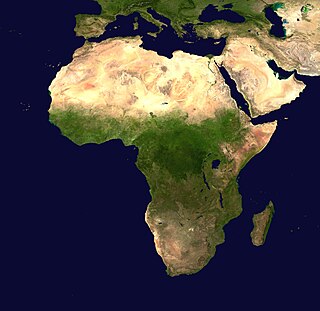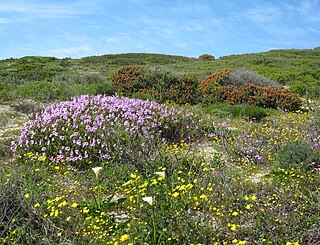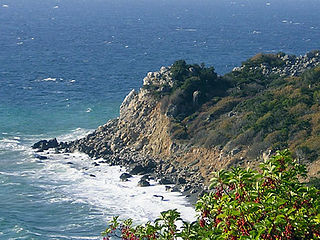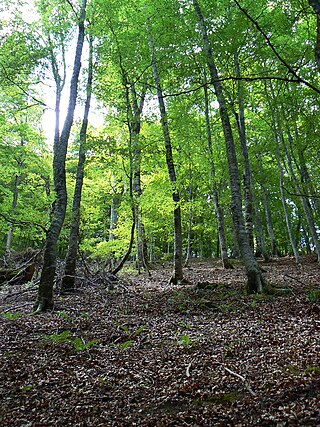
The natural history of Africa encompasses some of the well known megafauna of that continent.

Sclerophyll is a type of vegetation that is adapted to long periods of dryness and heat. The plants feature hard leaves, short internodes and leaf orientation which is parallel or oblique to direct sunlight. The word comes from the Greek sklēros (hard) and phyllon (leaf). The term was coined by A.F.W. Schimper in 1898, originally as a synonym of xeromorph, but the two words were later differentiated.

Laurel forest, also called laurisilva or laurissilva, is a type of subtropical forest found in areas with high humidity and relatively stable, mild temperatures. The forest is characterized by broadleaf tree species with evergreen, glossy and elongated leaves, known as "laurophyll" or "lauroid". Plants from the laurel family (Lauraceae) may or may not be present, depending on the location.

Giugliano in Campania, also known simply as Giugliano, is a city and comune (municipality) in the Metropolitan City of Naples, Campania, Italy. A suburb of Naples, as of 2017, it had some 124,000 inhabitants, making it the most populated Italian city that is not a provincial capital.

The woodlands of the Iberian Peninsula are distinct ecosystems on the Iberian Peninsula. Although the various regions are each characterized by distinct vegetation, the borders between these regions are not clearly defined, and there are some similarities across the peninsula.
The Nordhouse Dunes Wilderness is a 3,450-acre (14.0 km2) listed wilderness area within the Manistee National Forest. It is located north of Ludington, Michigan, and is best known for its 4 miles (6.4 km) of undeveloped Lake Michigan shoreline.
Saticula was a Caudini city near the frontier of Campania in southern Italy. In 343 BC, during the First Samnite War, the Roman consul Cornelius attacked it during the campaign against the Samnites in the Battle of Saticula.

The native flora of Chile is characterized by a higher degree of endemism and relatively fewer species compared to the flora of other countries of South America. A classification of this flora necessitates its division into at least three general zones: the desert provinces of the north, Central Chile, and the humid regions of the south.

The Coast Range ecoregion is a Level III ecoregion designated by the Environmental Protection Agency (EPA) in the U.S. states of Washington, Oregon, and California. It stretches along the Pacific Coast from the tip of the Olympic Peninsula in the north to the San Francisco Bay in the south, including Grays Harbor, Willapa Bay, and the Long Beach Peninsula in Washington, the entire length of the Oregon Coast, and the Northern California Coast. Named for the Coast Range mountains, it encompasses the lower elevations of the Olympic Mountains, the Oregon Coast Range, the Californian North Coast Ranges, and surrounding lowlands.

Licola is an area in the province of Naples which takes its name from Lago dei Follicoli, a lake which formerly occupied most of the area. The current population of Licola ranges between 4,000 and 5,000. Licola is a strip of land facing the sea, and is roughly three kilometers by ten kilometers in size. It begins at the foot of Mount Cuma and ends in Marina di Varcaturo.

Circeo National Park is an Italian national park founded in 1934. It occupies a strip of coastal land from Anzio to Terracina, including also a sector of forest in the mainland of San Felice Circeo, and the island of Zannone.

Cape Flats Dune Strandveld is an endangered vegetation type. This is a unique type of Cape Strandveld that is endemic to the coastal areas around Cape Town, including the Cape Flats.

Macassar Dunes Conservation Area is a 1,116-hectare (2,760-acre) coastal nature reserve in Macassar, within the City of Cape Town, South Africa.

The Eastern Isles are a group of twelve small uninhabited islands within the Isles of Scilly Area of Outstanding Natural Beauty, part of the Scilly Heritage Coast and a Site of Special Scientific Interest (SSSI) first designated in 1971 for its flora and fauna. They have a long period of occupation from the Bronze Age with cairns and entrance graves through to Iron Age field systems and a Roman shrine on Nornour. Before the 19th century, the islands were known by their Cornish name, which had also become the name of the largest island in the group after the submergence of the connecting lands.

Cape Martian Reserve, also known as Cape Martyan Reserve, is a nature reserve located on the southern coast of the Crimean Peninsula, near the Ukrainian city of Yalta and the Nikitsky Botanical Gardens. Established to protect its unique ecosystem and biodiversity, the reserve is home to many plant and animal species, some of which are specific to the Mediterranean climate of the region. Given its ecological importance, it plays a role in conservation and scientific research. Its picturesque landscapes overlooking the Black Sea also make it a point of interest for nature enthusiasts.

The Southeastern conifer forests are a temperate coniferous forest ecoregion of the southeastern United States. It is the largest conifer forest ecoregion east of the Mississippi River. It is also the southernmost instance of temperate coniferous forest within the Nearctic realm.
The wildlife of Syria is the flora and fauna of Syria, a country at the eastern end of the Mediterranean Sea. Besides its coastline, the country has a coastal plain, mountain ranges in the west, a semi-arid steppe area in the centre occupying most of the country, and a desert area in the east. Each of these zones has its own characteristic animals and plants.
Thamihla Kyun Wildlife Sanctuary is a protected area in Myanmar, located on the 0.88 km2 (0.34 sq mi) small uninhabited Diamond Island near the mouth of Pathein River. It was established in 1970 and is part of Ngaputaw Township in Ayeyarwady Region. It is managed by the Forest Department.
Sri Lanka exhibits a remarkable biological diversity and is considered to be the richest country in Asia in terms of species concentration.

The flora of Cantabria is the result of three determining factors: the climate, the composition of the soil, directly dependent on the types of existing rocks, and the evolutionary history of the different plant formations.
















